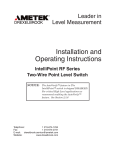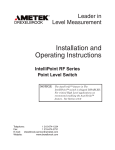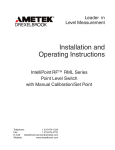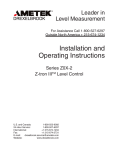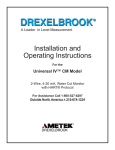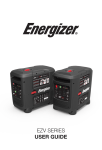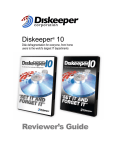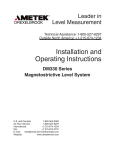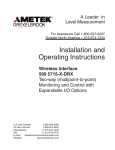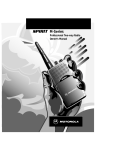Download Installation and Operating Instructions
Transcript
A Leader in Level Measurement Installation and Operating Instructions For the Clearline™ In-Line Fluid Detector Using 406-7000-000 Electronics For Assistance Call 1-800-527-6297 Outside North America + 215-674-1234 AMETEK Drexelbrook makes no warranty of any kind with regard to the material contained in this manual, including, but not limited to, implied warranties or fitness for a particular purpose. Drexelbrook shall not be liable for errors contained herein or for incidental or consequential damages in connection with the performance or use of material. © Copyright AMETEK Drexelbrook EDO# 1-15-102 506-7000-000-LM Issue # 3 Installation and Operating Instructions For the Clearline™ In-Line Fluid Detector Using 406-7000-000 Electronics For Assistance Call 1-800-527-6297 Outside North America + 215-674-1234 An ISO 9001 Certified Company 205 Keith Valley Road, Horsham, PA 19044 U.S. and Canada: 1-800-553-9092 24-Hour Service: 1-800-527-6297 International: +1 215-674-1234 Fax: +1 215-674-2731 E-mail:[email protected] Website: www.drexelbrook.com Table of Contents Section 1: Introduction......................................................................................................... 1 1.1 Introduction............................................................................................................ 1 1.2 Technology............................................................................................................. 1 1.3 System Description................................................................................................ 2 1.4 Housing.................................................................................................................. 3 1.5 Models Available.................................................................................................... 4 Section 2: Specifications..................................................................................................... 7 2.1 Electronics Specifications...................................................................................... 7 2.2 Sensor Specifications............................................................................................ 7 Section 3: Installation........................................................................................................... 9 3.1 Unpacking.............................................................................................................. 9 3.2 Wiring the Electronic Unit....................................................................................... 9 3.3 Wiring the Remote Sensing Element................................................................... 13 3.4 Mounting the Remote Electric Unit...................................................................... 14 3.5 Mounting the Sensing Element............................................................................ 14 Section 4: Operation.......................................................................................................... 17 4.1 Start-Up............................................................................................................... 17 4.2 Controls................................................................................................................ 17 4.3 Fall-Safe............................................................................................................... 17 4.4 Time Delay.......................................................................................................... 17 4.5 Special Applications............................................................................................. 18 4.6 Recalibration Procedure for Modif 91-22............................................................. 19 Section 5: Troubleshooting................................................................................................ 21 5.1 Introduction.......................................................................................................... 21 5.2 Checking the Electronic Unit................................................................................ 21 5.3 Checking the Relay.............................................................................................. 23 5.4 Troubleshooting Coaxial Cable............................................................................ 24 5.5 Checking the Sensing Element............................................................................ 25 5.6 Possible Problems and Solutions...................................................................... 26 5.7 Factory Assistance............................................................................................... 27 5.8 Field Service......................................................................................................... 27 5.9 Customer Training................................................................................................ 28 5.10 Return Equipment................................................................................................ 28 Section 1: Introduction Introduction Section 1: Introduction 1.1Introduction The instructions in this manual are for the Drexelbrook ClearLine™ InLine Fluid Detector is used to detect the presence or absence of material in a pipe. It provides relay operation when the normally full pipe is empty for a preset period of time. Calibration is performed through a simple potentiometer adjustment. 1.2Technology In a simple capacitance probe type sensing element, when the level rises and material covers the probe, the capacitance within the circuit between the probe and the media (conductive applications) or the probe and the vessel wall (insulating applications) increases. This is due to the higher dielectric constant (k) of the material which causes a bridge imbalance. The signal is demodulated (rectified), amplified, and the output is increased. There are drawbacks, however, especially when there is coating of the probe. An RF Admittance level transmitter is the next generation. Although similar to the capacitance concept, the ClearLine™ In-Line Fluid Detector employs a radio frequency signal and adds the Cote-Shield™ circuitry within the Electronics Unit. This patented Cote-Shield™ circuitry is designed into the ClearLine and enables the instrument to ignore the effect of buildup or material coating on the sensing element. The sensing element is mounted in the vessel and provides a change in RF admittance indicating presence or absence of material. The Cote-Shield element of the sensing element prevents the transmission of RF current through the coating on the sensing element. The only path to ground available for the RF current is through the material being measured. The result is an accurate measurement regardless of the amount of coating on the probe, making it by far the most versatile technology, good for very wide range conditions and works with many types of materials. 1 Clearline™ In-Line Fluid Detector - Installation and Operating Instructions 1.3 System Description The Drexelbrook ClearLine Series control consists of three major components. The ring-shaped sensor mounts in a vertical pipe run between two standard 150# flat faced or raised pipe flanges. The electronic unit includes the measuring circuit, customer connection terminals, and time delay. The sensor and remote electronic unit are connected by four-terminal cable. See Figure 1-1. The 406-7000 Series electronic unit is a precision radio frequency (RF) relay output instrument. It provides double-pole, double-throw relay contact closure when the process fluid has been absent in the pipe for a preset period of time. This In-Line Fluid Detector features Cote-ShieldTM electronics which enable the instrument to ignore the effects of material coatings or buildup on the sensor. The ring sensor is mounted in a vertical pipe run at a point where the presence/absence detection is desired. It consists of three sections: a center measuring electrode, a ground electrode, and a Cote-Shield electrode. When a coating or build-up occurs on the sensing element, the CoteShield electrode inhibits the flow of current from the center electrode to ground. The only path to ground available for the current is through the material being measured. This prevents a "full pipe" indication when only a coating is present. Figure 1-1 Typical sensing element with condulet. 700-4200 Series 2 Introduction 1.3 System Description (Continued) Note: Sensor must be mounted in a grounded metal section of pipe. Non-metallic or lined metal pipe can adversely affect the performance of the unit. Figure 1-2 Three-Terminal Ring Sensor 1.4Housing The 406-7000 Series electronics come standard in a housing without lights. An optional Nema 4 housing with red/green indicator lights available. 3 Clearline™ In-Line Fluid Detector - Installation and Operating Instructions 1.5 Models Available System Electronics and Sensing Element Model Technology CL Clear-Line In-Line Fluid Detector Voltage: 0 115 VAC 1 12-30 VDC 3 230 VAC Integral/Remote: 0 Integral 1 Remote Housing: 1 Powder coated aluminum 2 6x6 NEMA 4 with Lights Sensor Style: 0 Wafer Style Sensor Size: 2 2 inch (schedule 40 pipe size) 3 3 inch (schedule 40 pipe size) 4 4 inch (schedule 40 pipe size) 6 6 inch (schedule 40 pipe size) Material: B 316/316L SS Mounting: 00 None Cable Length: 0 None (Integral) 5 5 feet 10 10 feet 15 15 feet 20 20 feet Options: CL X X X 0 X B 00 X 00 None 01 Sludge mod 406-9100-022 XX 4 Introduction 1.5 Models Available (Continued) Sensing Element Dimensions and Process Connection Sensing Element Model # Nominal Pipe / ANSI Flange Size O.D. I.D. Width Pressure / Temperature Limits Integral / Remote Process Wetted Parts A* B* C* 700-4200-020 2” 3.36” 2.14” 1.69” 700-4200-030 3” 5.00” 100psi @ 340°F Remote TFE / 316 SST 3.15” 2.13” 100psi @ 340°F Remote TFE / 316 SST 700-4200-040 4” 700-4200-060 6” 6.19” 4.12” 2.38” 100psi @ 340°F Remote TFE / 316 SST 8.50” 6.20” 2.94” 100psi @ 340°F Remote 700-4200-920 TFE / 316 SST 2” 3.36” 2.14” 1.69” 100psi @ 340°F Integral TFE / 316 SST 700-4200-930 3” 5.00” 3.15” 2.13” 100psi @ 340°F Integral TFE / 316 SST 700-4200-940 4” 6.19” 4.12” 2.38” 100psi @ 340°F Integral TFE / 316 SST 700-4200-960 6” 8.50” 6.20” 2.94” 100psi @ 340°F Integral TFE / 316 SST * Reference figure XX.XX "C" "A" 5 13/16" "B" 2 3/4" Figure 1-3 Dimensional Drawing 5 Section 2: Specifications Specifications Section 2: Specifications 2.1 Electronics Specifications Power requirement: 120 ± 25 Vac, 50/60 Hz, 1 watt 240 ± 50 Vac, 50/60 Hz, 1 watt (optional) 12-30 Vdc 1 watt (optional) Ambient temperature: -40°F to 140°F (-40°C to 60°C) Level Output: DPDT relay Contact Rating: 120 Vac; 5A non-inductive, 3 A inductive 230 Vac; 5A non-inductive, 2 A inductive 24 Vdc; 5A non-inductive Min. Rating 100mA / 12VDC Time Delay: Adjustable 0-120 sec, for pump start/stop. Fail-safe Empty-pipe fail-safe (factory set); relay will de-energize, indicating empty pipe upon loss of power. RFI Protection (built in): The operating point for unit in housing is unaffected by 5W field @ 27 MHz, 150 MHz, or 450 MHz at a distance of 5 ft. from exposed sensor, cable, or power line. 2.2 Sensor Specifications Process Temperature and Pressure: 250°F @ 100 PSI (121°C @ 7 bar) Material Compatibility: Process-wetted parts: 316L SS & TFE Mounting - VERTICAL ONLY: Sensor must be mounted in a vertical run of pipe or sloping pipe run to provide material drainage 7 Section 3: Installation Installation Section 3: Installation 3.1Unpacking Carefully remove the contents of the shipping carton and check each item against the packing list before destroying any packing material. If there is any shortage or damage, report it immediately to the factory. 3.2 Wiring the Electronic Unit All power and relay connections are made to the terminal strips inside the electronic unit housing. Due to the low power consumption of the instrument (1 Watt), wiring need only follow local electrical codes. The power connections on units within the standard housing are made to terminals 1 and 2 and the green (GND) terminal on the electronic chassis. See Figure 3-1A. Power requirements are determined by the transmitter model type. 406-7000 requires 120Vac, 406-7100 requires 12-30Vdc, and 406-7300 requires 240Vac. The power connections on the optional Nema 4 unit are made to the terminal strip to the left of the electronic unit chassis. It has terminals for ground (gnd), neutral (neut), hot, and start. See Figure 3-1B. For wiring to customer-supplied motor starter, see Figures 3-2A and 3-2B. The relay connections for both housing types are made to the terminal strips on the front of the electronic unit chassis. The relay has double-pole, double-throw contacts (DPDT). See Figure 3-3. On the unit within the standard housing, both sets of contacts are available to the customer. See Figure 3- 1 A. The relay is a dry contact closure and cannot provide sufficient current to activate motors or heavy equipment (See specifications). On the optional Nema 4 unit, relay terminals 3, 4, and 5 are pre-wired to the alarm lights by the factory. For customer relay connections (terminals, 7,8, and 9), see Figures 3-1A and 3-1B. 9 Clearline™ In-Line Fluid Detector - Installation and Operating Instructions 3.2 Wiring the Electronic Unit (Continued) Figure 3-1B Customer connections to NEMA 4 unit. Figure 3-1A Customer connections to standard unit. Figure 3-2A Wiring for customer supplied pump starter (Standard unit) 10 Installation 3.2 Wiring the Electronic Unit (Continued) Figure 3-2B Wiring for customer supplied pump starter (Optional NEMA 4 unit) Figure 3-3 Relay Contact Position for Empty Pipe Fail-Safe 11 Clearline™ In-Line Fluid Detector - Installation and Operating Instructions 3.2 Wiring the Electronic Unit (Continued) All sensing element cable connections to the electronic chassis are made to the individual terminals on the side opposite the relay terminal strips. Be sure to match the colors on the terminals to the colors on the cable. See Figure 3-4. BLUE GREEN RED BLACK Figure 3-4 Cable Connections to Electronic Unit 12 Installation 3.3 Wiring the Remote Sensing Element The cable connections to the sensor have been pre-wired at the factory. If those connections come loose or the cable is being replaced, see Figure 3-5 and use the following procedure for proper wiring. 1. Remove the condulet cover. 2. Loosen the two screws and remove the cover plate labeled "remove for field wiring". 3. Wire the green, black and blue cable leads to the corresponding color coded screws as shown in Figure 3-5. 4. Slip the cover plate back under the two hold down screws. Slip the red (SH) lug under the red screw and tighten both screws. 5. Replace the condulet cover. Figure 3-5 Cable Connections to Sensing Element 13 Clearline™ In-Line Fluid Detector - Installation and Operating Instructions 3.4 Mounting the Remote Electric Unit The remote electronic unit is designed for wall mounting, and it should be mounted in a location that is as free as possible from vibration, corrosive atmospheres, and any possibility of mechanical damage. Ambient temperatures should be between -40°F and 140°F. For convenience at start-up, it is best to install the instrument in a reasonably accessible location. 3.5 Mounting the Sensing Element Sensor dimensions depend on sensor model, See Figure 3-6. Sensing Element Model # Nominal Pipe / ANSI Flange Size O.D. I.D. Width Pressure / Temperature Limits Integral / Remote Process Wetted Parts A* B* C* 700-4200-020 2” 3.36” 2.14” 1.69” 100psi @ 250°F Remote TFE / 316 SST 700-4200-030 3” 5.00” 700-4200-040 4” 6.19” 3.15” 2.13” 100psi @ 250°F Remote TFE / 316 SST 4.12” 2.38” 100psi @ 250°F Remote TFE / 316 SST 700-4200-060 6” 700-4200-920 2” 8.50” 6.20” 2.94” 100psi @ 250°F Remote TFE / 316 SST 3.36” 2.14” 1.69” 100psi @ 250°F Integral 700-4200-930 TFE / 316 SST 3” 5.00” 3.15” 2.13” 100psi @ 250°F Integral TFE / 316 SST 700-4200-940 4” 6.19” 4.12” 2.38” 100psi @ 250°F Integral TFE / 316 SST 700-4200-960 6” 8.50” 6.20” 2.94” 100psi @ 250°F Integral TFE / 316 SST * Reference figure XX.XX Remote Integral "C" "C" "A" "B" "A" 5 13/16" "B" 8 3/16" 2 3/4" 4 5/16" Figure 3-6 Dimensional Drawing 14 Installation 3.5 Mounting the Sensing Element (Continued) Before mounting the sensing element, do a quick operational check to be sure the system is working properly. With the power on, the lid removed, and the cable connected between the sensor and the electronic unit, touch the center element of the sensor. The green LED on the top of the unit will light. Remove your hand from the sensor and, after the set delay time has passed, the LED will go out. 1. Be sure to mount the sensor in a vertical run of grounded metal pipe. This will allow the process fluid to drain whenever the flow is interrupted. See Figure 3-7. Nonmetallic or lined pipe will adversely affect the performance of the unit. Consult factory. 2. Mount the sensor between two 150# or 300# raised or flat faced flanges only. For use with other flange types, consult factory. 3. Use full face gaskets, compatible with the process fluid. 4. Install the ground strap under the flange bolt nearest the sensor condulet to insure proper electrical contact. (See Figure 3-7.) 5. Tighten the flange bolts evenly to insure a proper seal. Check to make sure there is slack in the ground strap and repositions the ground washer if necessary. A. All bolts should be put in place and hand tightened evenly. B. All bolts should be tightened in 10ft-lb increments using a star pattern. C. Torque all bolts to 50ft-lb max. It is important that the sensor be torqued gradually and evenly to prevent cracking. Caution: Nominal sensor size must be the same or smaller than the diameter of the mating pipe run. This should allow the sensor to be full during normal pump operation. Figure 3-7 Mounting the Sensor 15 Section 4: Operation Operation Section 4: Operation 4.1 Start-Up 4.2 Controls Before applying power to the instrument, be sure that the wiring connections are correct. The Clearline in-line fluid detector is factory calibrated for proper operation. No calibration adjustments are normally needed. For specific applications using modification 91-22, See Section 4.5. 4.3Fall-Safe Fail-safe describes the relay contact position when power to the unit is lost. The 406-7000 Series electronic unit is available only with empty pipe Fail-Safe. This means the relay will de-energize with an empty pipe, or upon loss of instrument power. 4.4 Time Delay The time delay adjustment is located on top of the electronic unit chassis. See Figure 4-1. The standard time delay is adjustable from 0-120 seconds. The purpose of the time delay is to allow the pump to prime itself or ignore voids in the process stream for a preset time period. Turning the adjustment clockwise (CW) will increase the time delay, and turning it counterclockwise (CCW) will decrease the time delay. See Figure 4-1. The time delay period can be initiated by the momentary introduction of line voltage to the start terminal. This allows the pump to prime itself in "suction lift" installations. Figure 4-1 Time Delay Control 17 Clearline™ In-Line Fluid Detector - Installation and Operating Instructions 4.5 Special Applications The Clear Line In-Line Fluid Detector is factory calibrated for proper operation. No field calibration adjustments are needed. The standard units are calibrated for use in both insulating and conducting fluids, with the ability to ignore most residual fluid coatings on the sensor even when the pipe is empty. The electronic units used for sewage applications (4067001 modif.91-22) are calibrated differently. Because the fluids in waste treatment applications are always conductive, these units are calibrated specifically for conductive liquids. This increases the unit's ability to ignore conductive fluid coatings on the sensor when the pipe is empty. Under special circumstances, the factory calibration for the water and Waste treatment applications may prove, over an extended period of time, to be inadequate. Occasionally, a permanent coating of different character than the bulk material being pumped will develop on the inside of the sensor and pipe. This coating may be either greasy or dry and crusty. In any case, it is not washed away by the fluid flow and tends to build up over time. When this permanent coating reaches a critical thickness, it will interfere with the unit's ability to ignore a wet coating of the bulk material when the pipe is actually empty. This can result in a false "full" indication when the pipe is empty, which could possibly cause pump damage. The "critical" thickness is difficult to specify because it is dependent on the highly variable electrical properties of both the bulk material and the permanent coating. If the previously described coating is typical in your application, a periodic empty pipe simulation is recommended to ensure the unit is operating properly. There are available indication two corrective steps when a false "full" occurs. 1. Periodic cleaning of the sensor will help to increase the reliability of the sensor signal. When the sensor is clean, it will function properly as calibrated. 2. It may be necessary to recalibrate the unit. 18 Operation 4.6 Recalibration Procedure for Modif 91-22 1. Remove the "preset" label on the top of the electronic unit for access to the setpoint adjustment assembly (this is the hex nut visible inside the chassis after the label has been removed). See Figure 7-1. 2. Using the tuning wrench supplied, (blue plastic tube with a pointer) back out the setpoint adjustment nut until it is fully counterclockwise (CCW). See Figure 7-2. 3. When the sensor is known to be flooded and power is applied to the system, slowly advance the setpoint adjustment clockwise (CW) until the LED on the unit is out or the indicating lights on the Nema 4 housing door trip from green to red. Please count and record the number of turns re quired in this step with the use of the pointer on the Blue tuning wrench. 4. Back off the setpoint adjustment 1 full turn counterclockwise (CCW). Remove the tuning wrench and secure it somewhere in the housing. The ClearLine In-Line Fluid Detector should have its LED or green indicating LED Illuminated; corresponding to the flooded/full pipe condition. Recalibration is complete. Note: To verify proper system operation, the pipe should then be emptied. After the passage of the time delay period, the system should switch and indicate an empty pipe. To reduce pump ,wear during the test, the relay control can be reset to its shortest period (approximately .5 seconds). To do this, simply turn the adjustment to its full counterclockwise (CCW) position. Do not forget to reset the time delay after the empty pipe test. Figure 7-1 Setpoint Adjustment for Modif. 91-22 19 Section 5: Troubleshooting Troubleshooting Section 5: Troubleshooting 5.1Introduction The Clearline In-Line Fluid Detector is designed to give years of unattended service. No periodic or scheduled maintenance is required. There are no specific spare parts that we recommend be stocked by the user. However, if the application is critical, it is best to have a spare electronic unit chassis available in the event of a component failure. If difficulty should occur when operating your in-line fluid detector, divide the system into its component parts and test each part individually for proper operation. The following troubleshooting procedures should be used in checking out your system. If attempts to solve the difficulty fail, notify our local representative or call the factory directly and ask for the service department. 5.2 Checking the Electronic Unit Before checking the components separately, check all wiring connections to both the electronic unit and sensing element. Be sure to match the cable wire sleeve colors to the terminal screw colors on the electronic unit. 1. Disconnect the sensor cable from the electronic unit. Leave the power connected. See Figure 5-1. 2. Put a capacitor, any value from 10 pF to 12 pF, across the blue center (CW) connection and the green ground (gnd). Figure 5-1 Testing the Electronic Unit 21 Clearline™ In-Line Fluid Detector - Installation and Operating Instructions 5.2 Checking the Electronic Unit (Continued) 3. With the capacitor attached, the relay will change state, the LED on top of the electronic unit will illuminate, and the green light on the housing door will also be lit (optional Nema 4 housing only). 4. Remove the capacitor, and after a delay time of 0-120 seconds*, the relay will switch; the LED on the top of the unit will turn off, but the red light on the housing door will be illuminated (optional Nema 4 housing only). 5. To check the integrity of the push-to-start function: Remove Power, detach the wire from the start terminal (See Figure 5-2) and add a jumper wire from the "hot" terminal to the "start" terminal. Apply Power 6. Again, the relay will switch. The LED will illuminate and the green light on the housing door will be lit (optional Nema 4 housing only). After the preset time delay period has passed*, the relay will switch again; the LED will go out and the red LED on the housing door will be lit (optional Nema 4 housing only). *Note: To disengage the time delay, mark the original position of the adjustment, then turn to the full counterclockwise (CCW) position. Be sure to reset the time delay to its original position after checking the electronic unit. GND COM HOT START JUMPER Figure 5-2 Checking the "Start" circuit 22 Troubleshooting 5.3 Checking the Relay 1. The relay output circuit consists of double pole doublethrow (DPDT) relay contacts brought out to a terminal strip. When the relay is operating properly, the following conditions will apply: A. The LED on the top of the electronic unit chassis should be lit when relay contacts 4 and 5, and 8 and 9 are closed. B. The LED should be out and 7 and 8 are closed. 2. Relay operation may be heard as an audible click if the background noise is not too high. Use one of the methods shown in Figure 5-4 to determine if the relay contacts are switching. Relay in Energized Condition Relay in DeEnergized Condition Figure 5-3 Relay Contact Chart Figure 5-4 Checking the Relay Circuits 23 5 4 3 5 4 9 3 8 7 9 8 7 5 4 3 5 4 9 3 8 7 9 8 7 Clearline™ In-Line Fluid Detector - Installation and Operating Instructions 5.4 Troubleshooting Coaxial Cable If there is water or other conductive material in the conduit (i.e.: Excessive wire lube) it can change the electrical properties of the coax cable and cause the system to perform poorly. Moisture in the conduit may not be detected by the following test. The only sure way is to inspect the coax and associated conduit for trapped water. 1. Disconnect all wires of the coaxial cable at the electronic unit. 2. Disconnect all wires at the sensing element end of the coax. 3. Using an ohmmeter, measure between the black and green lugs of the coaxial cable. Note any reading. Repeat for the red and blue lugs. All readings should show an open circuit, (infinite resistance). OHMMETER ∞ 0 OHMMETER ∞ 0 CHECK FOR SHORT CIRCUIT BLACK - GREEN OHMS RED - BLUE OHMS CHECKREADING FOR SHORT CORRECT = OPENCIRCUIT CIRCUIT BLACK - GREEN OHMS RED - BLUE OHMS CORRECT READING = OPEN CIRCUIT NO CONNECTION Figure 5-5 Checking the Cable for a Short Circuit OHMMETER ∞ 0 OHMMETER ∞ 0 4. Check for continuity of each conductor. Short out the black and green NO CONNECTION lugs of the coaxial cable and measure these two conductors at the other end. A reading <CHECK 10ohmsFOR indicates a good cable. Move the short to the red CONTINUITY and blue lugs and repeat. BLACK - GREEN OHMS RED - BLUE OHMS CHECK FOR CONTINUITY SHORTED WIRES SHOULD READ < 10 OHMS BLACK - GREEN OHMS RED - BLUE OHMS SHORTED WIRES SHOULD READ < 10 OHMSSHORT TWO CONDUCTORS SHORT TWO CONDUCTORS Figure 5-6 Checking the Cable for Continuity 24 Troubleshooting 5.5 Checking the Sensing Element A thorough check of the sensor requires factory service equipment. However, the following test can be done with only an ohmmeter to help determine the cause of a possible malfunction. If this test indicates the sensor is not functioning properly, or if none of the checkout procedures indicate a problem but the system is still not operating properly, please call the factory Service Department. 1. Disconnect the measuring cable from the sensor terminals. See Figure 5-6. 2. Use an ohmmeter to measure the resistance between the sensor terminals. See the chart below. Figure 5-6 Checking the Sensing Element 25 Clearline™ In-Line Fluid Detector - Installation and Operating Instructions 5.6 Possible Problems and Solutions Symptoms Possible Causes Solution 1. Both red and green lights on the A. No voltage between 'Hot' and A. Check wiring. See Sec. 3. 2 optional Nema 4 housing are out 'Neutral' terminals. B. Replace defective bulbs on cover door. B. One or both light bulbs are 'burnt C. See sec. 5. 2 and 5. 3. out'. C. Electronic unit malfunction. 2. LED on chassis or Green cover light is on, even when pipe is known to be empty. A. Defect in cable. B. Electronic unit malfunction. C. Sensor malfunction. D. Sensor not mounted properly. E. Heavy coating build-up on sensor. A. See Section 5.4 B. See Section 5.2 and 5.3. C. See Section 5.5 D. Mount sensor in vertical run of pipe. See Section 3.5. E. Consult factory. 3. LED on chassis is out or Red cover light is on even when pipe is known to be full. A. Defect in cable. B. Electronic unit malfunction. C. Sensor malfunction D. Adjoining pipe not grounded. E. Adjoining pipe not metallic A. See Section 5.4 B. See Section 5.2 & 5.3 C. See Section 5.5 D. Ground pipe using ground strap on sensor. See Section 3.5 E. Mount sensor only in non-lined metal pipe. 4. Motor Starter does not respond as intended. A. Correct customer wiring to pipeline fluid sensor. B. No power at either customer supplied starter or pipe-line fluid sensor. C. Time delay set for too short or too long a period. D. Electronic unit malfunction. A. Check wiring. See Sec. 3. 2. B. Check power wiring. See Sec. 3.2. C. Adjust time delay. See Sec. 4.4 D. See Sec. 5.2 and 5.3. 5. Instrument operates intermittently A. Loose wiring. B. Ground strap not connected properly. C. Electronic unit malfunction. D. Voids in the process stream are longer than the time delay period. E. Sensor malfunction. A. Check wiring. See Sec 3.2. B. See Sec. 3.5. C. See Sec. 5. 2 and 5.3. D. Increase the time delay period. See Sec. 4.4 E. See Sec. 5.5. 26 Troubleshooting 5.7 Factory Assistance AMETEK Drexelbrook can answer any questions about your level measurement system. For Technical Support: 1-800-527-6297 All other inquiries: Call Customer Service at 1-800-553-9092 (US and Canada) , or + 215-674-1234 (International). If you require assistance and attempts to locate the problem have failed: • • For Technical Assistance call toll-free: 1-800-527-6297 (US and Canada) or + 215-674-1234 (International), FAX: + 215-443-5117, • E-mail: [email protected] Please provide the following information: • Instrument Model and Serial Numbers • Sensing Element Model Number and Length • Material being measured • Temperature • Pressure • Agitation • Brief description of the problem • Checkout procedures performed and results 5.8 Field Service Trained field service engineers are available on a time-plus-expense basis to assist in start-ups, diagnosing difficult application problems, or in-plant training of personnel. Contact the service department for further details. 27 Clearline™ In-Line Fluid Detector - Installation and Operating Instructions 5.9 Customer Training Periodically, AMETEK Drexelbrook instrument training seminars for customers are held at the factory. These sessions are guided by Drexelbrook engineers and specialists, and provide detailed information on all aspects of level measurement, including theory and practice of instrument operation. For more information about these valuable workshops, write to AMETEK Drexelbrook, attention: Communications/ Training Group, or call direct + 215-674-1234. 5.10 Return Equipment Any equipment being returned for evaluation or credit must be preapproved by the factory. In many applications, sensing elements are exposed to hazardous materials. • OSHA mandates that our employees be informed and protected from hazardous chemicals. • Material Safety Data Sheets (MSDS) listing the hazardous materials to which the sensing element has been exposed MUST accompany any repair. • It is your responsibility to fully disclose all chemicals and decontaminate the sensing element. To obtain a return authorization (RA#), contact the Service department at 1-800-527-6297 (US and Canada) or + 215-674-1234 (International). Please provide the following information: • • • • • • • Model Number of Return Equipment Serial Number Process Materials to which equipment has been exposed MSDS sheets for any hazardous materials Billing Address Shipping Address Purchase Order No. For Replacement / evaluation Please include a purchase order even if the returned unit is under warranty. If repair is covered under warranty, you will not be charged. Ship equipment freight prepaid to: AMETEK Drexelbrook 205 Keith Valley Road Horsham, PA 19044-1499 COD shipments will not be accepted. 28 Form 440-0001-001 3/1/2006 TERMS AND CONDITIONS OF SALE GENERAL: ALL ORDERS ARE SUBJECT TO THE FOLLOWING TERMS AND CONDITIONS. ANY ACCEPTANCE OF ANY OFFER OF BUYER FOR ANY GOODS OR SERVICES IS CONDITIONED UPON THESE TERMS AND CONDITIONS, AND SELLER OBJECTS TO ANY ADDITIONAL OR DIFFERENT TERMS PROPOSED BY BUYER IN ANY DOCUMENT, WHICH SHALL NOT BE BINDING UPON SELLER. No salesman or other party is authorized to bind the AMETEK DREXELBROOK Division of AMETEK, Inc. (hereinafter “Seller”) by any agreement, warranty, statement, promise, or understanding not herein expressed, and no modifications shall be binding on Seller unless the same are in writing and signed by an executive officer of Seller or his or her duly authorized representative. Verbal orders shall not be executed until written notification has been received and acknowledged by Seller. QUOTATIONS: Written quotations are valid for thirty (30) days unless otherwise stated. Verbal quotations expire the same day they are made. PRICES: All prices and terms are subject to change without notice. Buyer-requested changes to its order (“Orders”), including those affecting the identity, scope and delivery of the goods or services, must be documented in writing and are subject to Seller’s prior approval and adjustments in price, schedule and other affected terms and conditions. Orders requiring certified test data in excess of commercial requirements, are subject to a special charge. ORDER ACCEPTANCE: All Orders are subject to final approval and acceptance by Seller at its office located at 205 Keith Valley Road, Horsham, Pennsylvania 19044. TERMS OF PAYMENT: Seller’s standard terms of payment for Buyers who qualify for credit are net thirty (30) days from date of invoice. All invoices must be paid in United States dollars. CREDIT: Seller reserves the right at any time to revoke any credit extended to Buyer or otherwise modify terms of payment if Buyer fails to pay for any shipments when due or if in Seller’s opinion there is a material adverse change in Buyer’s financial condition. Seller may, at its option, cancel any accepted Order if Buyer fails to pay any invoices when due. DELIVERY: Shipments are F.O.B place of manufacture (“Shipping Point”) and the Buyer shall pay all freight, transportation, shipping, duties, fees, handling, insurance, storage, demurrage, or similar charges from Shipping Point. Delivery of goods to common carrier shall constitute delivery and passing of title to the Buyer, and all risk of loss or damage in transit shall be borne by Buyer. Any claims or losses for damage or destruction after such delivery shall be the responsibility of Buyer. Seller reserves the right to make delivery in installments which shall be separately invoiced and paid for when due, without regard to subsequent deliveries. Delay in delivery of any installment shall not relieve Buyer of its obligation to accept remaining deliveries. Acknowledged shipping dates are approximate only and based on prompt receipt of all necessary information from Buyer and Buyer’s compliance with terms of payment. TAXES: All sales, excise and similar taxes which Seller may be required to pay or collect with respect to the goods and/or services covered by any Order, shall be for the account of the Buyer except as otherwise provided by law or unless specifically stated otherwise by Seller in writing. TERMINATION AND HOLD ORDERS: No Order may be terminated by Buyer except upon written request by Buyer and approval by Seller, and if said request is approved by Seller, under the following conditions: (1) Buyer agrees to accept delivery of all of the units completed by Seller through the workday on which Seller receives the written termination request; (2) Buyer agrees to pay to Seller all direct costs and expenses applicable to the portion of the Order that is incomplete. WARRANTY: A. Hardware: Seller warrants its goods against defects in materials and workmanship under normal use and service for one (1) year from the date of invoice. B. Software and Firmware: Unless otherwise specified, Seller warrants for a period of one (1) year from date of invoice that standard software or firmware, when used with Seller specified hardware, shall perform in accordance with Seller’s published specifications. Seller makes no representation or warranty, expressed or implied, that the operation of the software or firmware shall be uninterrupted or error-free, or that functions contained therein shall meet or satisfy the Buyer’s intended use or requirements. C. Services: Seller warrants that services, including engineering and custom application, whether provided on a fixed cost or time and material basis, shall be performed in accordance with generally accepted industry practices. D. Remedies: Seller’s liability under this section is restricted to replacing, repairing, or issuing credit (at Seller’s option) for any returned goods and only under the following conditions: (1) Seller must be promptly notified, in writing, as soon as possible after the defects have been noted by the Buyer, but not later than (1) year from date of invoice from Seller; (2) The defective goods are to be returned to the place of manufacture, shipping charges prepaid by the Buyer; (3) Seller’s inspection shall disclose to its satisfaction that the goods were defective in materials or workmanship at the time of shipment; (4) Any warranty service (consisting of time, travel and expenses related to such services) performed other than at Seller’s factory, shall be at Buyer’s expense. E.Repaired/Reconditioned Goods: As to out-of-warranty goods which Seller has repaired or reconditioned, Seller warrants for a period of sixty (60) days from date of its invoice only new components replaced in the most recent repair/reconditioning. F. Returns and Adjustments: No goods may be returned unless authorized in advance by Seller and then only upon such conditions to which Seller may agree. Buyer must obtain an RMA (Return Material Authorization) number from Seller prior to any return shipment and such RMA number must appear on the shipping label and packing slip. Buyer shall be responsible for the returned goods until such time as Seller receives the same at its plant and for all charges for packing, inspection, shipping, transportation, or insurance associated with returned goods. In the event that credit for returned goods is granted, it shall be at the lesser of the then current prices or the original purchase price. Claims for shortage or incorrect material must be made within five (5) days after receipt of shipment. ALL OTHER WARRANTIES, FOR ANY OF SELLER’S GOODS OR SERVICES, WHETHER ORAL, WRITTEN, EXPRESS, IMPLIED, STATUTORY OR OTHERWISE, INCLUDING WITHOUT LIMITATION ANY IMPLIED WARRANTY OF MERCHANTABILITY OR FITNESS FOR PURPOSE ARE EXCLUDED. INTELLECTUAL PROPERTY: Seller’s sale of goods or provision of related documentation or other materials to Buyer shall not transfer any intellectual property rights to Buyer unless Seller specifically agrees to do so in writing. Seller shall retain ownership of all applicable patents, trademarks, copyrights and other intellectual property rights. Buyer shall not use, copy or transfer any such items in violation of Seller’s intellectual property rights or applicable law, or for any purposes other than that for which the items were furnished. Seller shall defend any lawsuit brought against the Buyer based on a claim that the design or construction of the goods sold hereunder by Seller infringe any United States or Canadian Patent, Copyright or Mask Work Registration, provided that Buyer promptly notifies Seller of such claim in writing and further provided that, at Seller’s expense, (1) Buyer gives Seller the sole right to defend or control the defense of the suit or proceeding, including settlement, and (2) Buyer provides all necessary information and assistance for that defense. In the event of a charge of infringement, Seller’s obligation under the agreement shall be fulfilled if Seller, at its option and expense, either (i) settles such claim; (ii) procures for Buyer the right to continue using such goods; (iii) replaces or modifies goods to avoid infringement; or (iv) accepts the return of any infringing goods and refunds their purchase price; or (iv) defends against such claim. If Buyer furnishes specifications or designs to Seller, the obligations of Seller set forth above shall not apply to goods made by Seller using such specifications or designs, and Buyer shall defend, indemnify and hold Seller harmless against any third party claims for infringement which arise out of Seller’s use of specifications or designs furnished by Buyer. SOFTWARE LICENSE: If goods purchased hereunder include software (“Software”), Buyer may use the Software only as part of the goods. Buyer may not use, copy, or transfer any of the Software except as may be permitted under the applicable License Agreement provided with the goods. Buyer’s right to use, copy or transfer the Software shall terminate upon termination of Buyer’s right to use the goods. PACKAGING/WEIGHTS AND DIMENSIONS: Buyer specified packing or marking may be subject to additional charges not otherwise included in the price of the goods. Published weights and dimensions are estimates or approximate only and are not warranted. FORCE MAJEURE: Seller shall not be responsible for delays in delivery or any failure to deliver due to causes beyond Seller’s control, including but not limited to the following items: acts of God, war, terrorism, mobilization, civil commotion, riots, embargoes, domestic or foreign governmental regulations or orders, governmental priorities, port congestion, acts of the Buyer, its agents or employees, fires, floods, strikes, lockouts and other labor difficulties, shortages of or inability to obtain shipping space or transportation, inability to secure fuel, supplies or power at current prices or on account of shortages thereof, or due to limitations imposed by the extent of availability of Seller’s normal manufacturing facilities. If a delay excused per the above extends for more than ninety (90) days and the parties have not agreed upon a revised basis for continuing providing the goods or services at the end of the delay, including adjustment of the price, then Buyer, upon thirty (30) days’ prior written notice to Seller may terminate the Order with respect to the unexecuted portion of the goods or services, whereupon Buyer shall promptly pay Seller its reasonable termination charges upon submission of Seller’s invoices thereof. LIMITATION OF LIABILITY: Seller’s liability for any claim of any kind, except infringement of intellectual property rights, shall not exceed the purchase price of any goods or services which give rise to the claim. SELLER SHALL IN NO EVENT BE LIABLE FOR BUYER’S MANUFACTURING COSTS, LOST PROFITS, LOSS OF USE OF THE GOODS OR SERVICES, COST OF CAPITAL, COST OF SUBSTITUTE GOODS, FACILITIES, SERVICES OR REPLACEMENT POWER, DOWNTIME COSTS, CLAIMS OF BUYER’S CUSTOMERS FOR DAMAGES, OR OTHER SPECIAL, PROXIMATE, INCIDENTAL, INDIRECT, EXEMPLARY OR CONSEQUENTIAL DAMAGES. Any action against Seller must be brought within eighteen (18) months after the cause of action accrues. These disclaimers and limitations of liability shall apply regardless of the form of action, whether in contract, tort or otherwise, and further shall extend to the benefit of Seller’s vendors, appointed distributors and other authorized resellers as third-party beneficiaries. PROHIBITION FOR HAZARDOUS USE: Goods sold hereunder generally are not intended for application in and shall not be used by Buyer in the construction or operation of a nuclear installation or in connection with the use or handling of nuclear material, or for any hazardous activity or critical application, where failure of a single component could cause substantial harm to persons or property, unless the goods have been specifically approved for such a use or application. Seller disclaims all liability for any loss or damage resulting from such unauthorized use and Buyer shall defend, indemnify and hold harmless the Seller against any such liability, whether as a result of breach of contract, warranty, tort (regardless of the degree of fault or negligence), strict liability or otherwise. EXPORT CONTROL: Buyer shall comply with all export control laws and regulations of the United States, and all sales hereunder are subject to those laws and regulations. Seller shall not be named as shipper or exporter of record for any goods sold hereunder unless specifically agreed to in writing by Seller. At Seller’s request, Buyer shall furnish Seller with end-use and end-user information to determine export license applicability. Buyer warrants, in accordance with U.S. Export Law, that goods sold hereunder shall not be destined for facilities or activities involving nuclear, chemical or biological weapons, or related missile delivery systems in named prohibited regions or countries. GOVERNING LAW: Seller intends to comply with all laws applicable to its performance under any order. All matters relating to interpretation and effect of these terms and any authorized changes, modifications or amendments thereto shall be governed by the laws of the Commonwealth of Pennsylvania. No government contract regulations or clauses shall apply to the goods or services, this agreement, or act to bind Seller unless specifically agreed to by Seller in writing. NON-WAIVER BY SELLER: Waiver by Seller of a breach of any of these terms and conditions shall not be construed as a waiver of any other breach. SEVERABILITY AND ENTIRE AGREEMENT: If any provision of these terms and conditions is unenforceable, the remaining terms shall nonetheless continue in full force and effect. This writing, together with any other terms and conditions Seller specifically agrees to in writing, constitutes the entire terms and conditions of sale between Buyer and Seller and supercedes any and all prior discussions, and negotiations on its subject matter. An ISO 9001 Certified Company 205 Keith Valley Road, Horsham, PA 19044 U.S. and Canada: 1-800-553-9092 24-Hour Service: 1-800-527-6297 International: +1 215-674-1234 Fax: +1 215-674-2731 E-mail:[email protected] Website: www.drexelbrook.com





































